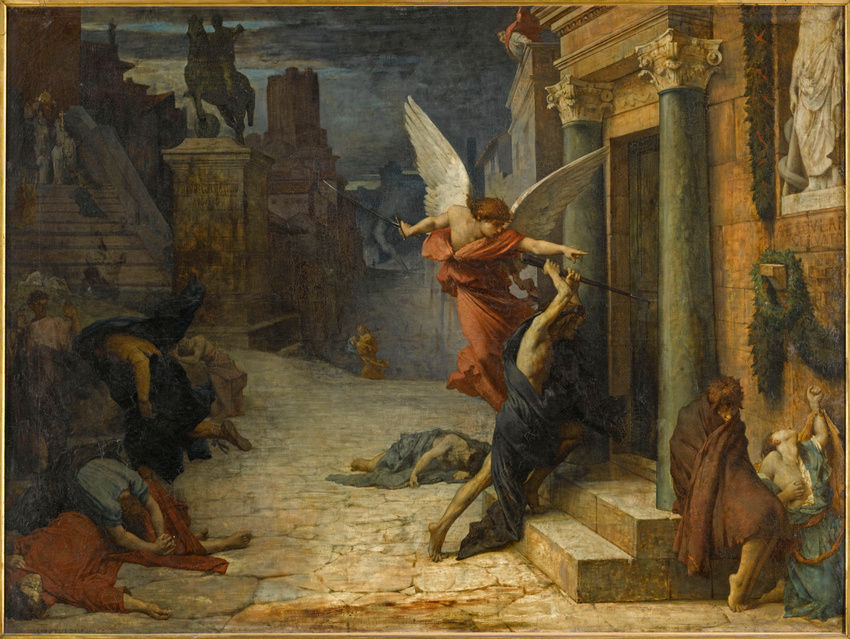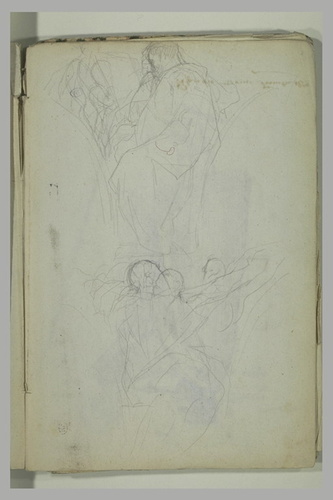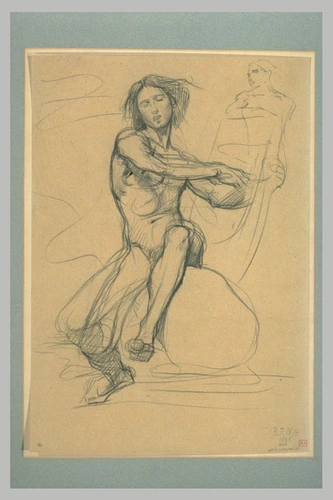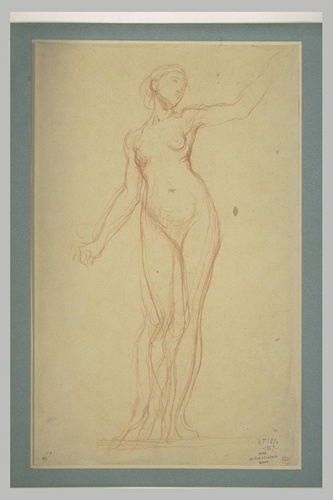Peste à Rome

The first preparatory drawings for this painting date from 1857 and were inspired by the artist's visit to the Roman Church of San Pietro in Vicoli, where a fresco from 1476 depicted a plague epidemic. At the time when Delaunay was painting his picture, the disease was no longer the scourge it had been for so long and he refers to it through a literary transposition: a passage from Jacobus de Voragine's Golden Legend telling the story of Saint Sebastian, which reads: "And then there appeared a good angel, who commanded a bad angel, armed with a pike, to strike the houses and each house had as many dead as the number of blows on the door".
Around a central void, closed in the background by a few houses, fugitives and the equestrian statue of Marcus Aurelius, the painter has arranged several plague victims, in the shadows lower left, counterbalanced by the two angels heralding terror, in full light, on the right. In the lower right-hand corner, two figures are huddled at the foot of the statue of its Aesculapius (the Roman god of medicine), partly visible in an alcove above them. In the upper left-hand corner, a procession of priests in white surplices is advancing behind a gilded processional cross.
Life and death, paganism and Christianity are therefore opposed in this painting which wavers between symbolism and fantasy and was one of the most acclaimed and commented works in the Salon in Paris in 1869.

avec cadre H. 169,5 ; L. 216 cm
- 1869, achat au salon (acquis sur la liste civile de Napoléon III en 1869)
- en 1869, collection Napoléon III
- de 1872 à 1929, musée du Luxembourg, Paris (entrée le 26 février 1872, sortie le 21 janvier 1929)
- 1929, attribué au musée du Louvre, Paris
- 1929-1978, musée du Louvre, Paris
- 1978, affecté au musée d'Orsay, Paris
- Salon - palais des Champs Elysées - France, Paris, 1869, n° 684
- I. Internationalen Kunstausstellung - Glaspalast - Allemagne, Munich, 1869, n° 1528
- Salon - organisme inconnu - Tchèque, République, Prague, 1870, n° 19
- Exposition Universelle - palais du Trocadéro - France, Paris, 1878, n° 244
- Franco-British Exhibition - Sepherd's Bush Fine Arts Palace - Royaume-Uni, Londres, 1908, n° 154
- Pintura Francesa Contemporanea 1870-1914 - organisme inconnu - Espagne, Madrid, 1918, n° 56
- München 1869-1958- Aufbruch zur modern kunst - Haus der Kunst - Allemagne, Munich, 1958, n° 35
- Le Salon Imaginaire - Bilder aus den grossen kunstauss tel hunger der zweiten Hälfte des XIX Jahrhunderts - Kunstverein - Allemagne, Berlin, 1968, sans n°
- "Equivoques" : peintures françaises du XIXe siècle - musée des Arts décoratifs - France, Paris, 1973, sans n°
- Le musée du Luxembourg en 1874 - peintures - Galeries nationales du Grand Palais - France, Paris, 1974
- Gustave Moreau et le symbolisme - Prefectural Museum of Art - Japon, Yamanashi, 1984
- Gustave Moreau et le symbolisme - Museum of Modern Art - Japon, Sakura, 1984
- Gustave Moreau et le symbolisme - Mie Prefectural Art Museum - Japon, Mie, 1985
- Edmond About écrivain et critique d'art (1828-1885) - palais de Tokyo - musée d'Art et d'Essai - France, Paris, 1985, sans n°
- From Courbet to Cézanne, a new 19th century - Preview of the Musée d'Orsay, Paris - Brooklyn Museum - Etats-Unis, New York, 1986
- Jules-Elie Delaunay 1828-1981 - musée des Beaux-Arts - France, Nantes, 1988, n° 45
- Rêve et réalité - Collections du Musée d'Orsay - City museum - Japon, Kobe, 1999
- Gloria Victis ! Tradition og nybrud i fransk kunst 1848-1910 - Ny Carlsberg Glyptotek - Danemark, Copenhague, 2000, n° 5
- De tijd van Degas - Gemeentemuseum - Pays-Bas, La Haye, 2002
- Maestà di Roma - Da Napoleone all'Unità d'Italia - Da Ingres a Degas, gli artisti francesi a Roma - Académie de France - Italie, Rome, 2003, n° 201
- French Artists in Rome : Ingres to Degas, 1803-1873 - Dahesh Museum of Art - Etats-Unis, New York, 2003, sans n°, p. 57
- Naissance de l'impressionnisme - National Art Center - Japon, Tokyo, 2014
- El canto del cisne. Pinturas académicas del Salón de Paris. Colecciones Musée d'Orsay - Fundación Mapfre - Espagne, Madrid, 2015
- Patrice Chéreau. Un musée imaginaire - collection Lambert - musée d'art contemporain - France, Avignon, 2015
-
About, Edmond, Revue des deux mondes, "Le Salon de 1869", Paris, [s.n.], 1869
-
Albrespy, André, Revue chrétienne, "Le Salon de 1869", Paris, [s.n.], 1869, p. 6
-
Bouniol, Bathild, Revue du monde catholique, "L'Amateur au Salon de 1869", Paris, V. Palmé, 1869, p. 523-524
-
Cristal, M., Le Contemporain, "Le Salon de 1869", Paris, [s.n.], 1869, p. 850
-
Gautier, Théophile, L'Illustration, "Le Salon de 1869", Paris, [s.n.], 1869, p. 265-266
-
Mantz, Paul, Gazette des beaux-arts, "Le Salon de 1869", Paris, [s.n.], 1869, p. 499-500
-
Perier, Paul, Revue du salon, "Propos d'art à l'occasion du Salon de 1869", Paris, [s.n.], 1869, p. 120
-
Saint-Victor, P. de, La Liberté, "Le Salon de 1869", Paris, [s.n.], 1869
-
Silvestre, Armand, Revue moderne, "Le Salon de 1869", Paris, Lacroix, Verboeckhoven et Cie, 1869, p. 144-149
-
Dolent, Jean, Avant le déluge, Paris, Cournol, 1871, p. 63-64
-
Delaborde, Henri, Notice sur la vie et les oeuvres de M. Elie Delaunay, Paris, Institut de France ; Académie des Beaux-Arts, 1897, p. 10-13
-
Bénédite, Léonce, Le Musée du Luxembourg. Les peintures. Ecole française, Paris, H. Laurens, 1923, n° 168
-
Rosenblum, Robert, Les Peintures du Musée d'Orsay, Paris, Nathan, 1989, p. 54-55
-
Guégan, Stéphane ; Savy, Nicole, Regards d'écrivains au musée d'Orsay, Paris, Réunion des musées nationaux, 1992, p. 40
-
Roters, Eberhard, Malerei des 19. Jahrhunderts : Themen und Motive, Cologne, DuMont, 1998, p. 24
-
Lacambre, Geneviève, Le Musée du Luxembourg en 1874, cat.exp. (Paris, Grand Palais, 31 mai-18 novembre 1974), Paris, Réunion des musées nationaux, 1974, n° 66
-
Lacambre, Geneviève, Gustave Moreau et le Symbolisme, cat.exp. (Yamanashi, musée départemental d’Art, 9 septembre – 14 octobre 1984, Kamakura, musée d’Art moderne, 27 octobre – 2 décembre 1984, Mié, musée départemental d’Art, 4 janvier – 11 février 1985), Tokyo, Tokyo Shimbun, 1984, n° 11
-
Cogeval, Guy, From Courbet to Cézanne : A New 19th Century : Preview of the Musée d'Orsay, Paris, cat. Exp. (Paris, musée d'Orsay, à Brooklyn, Museum of Art et à Dallas, Museum of Art), Paris, Réunion des musées nationaux, 1986, n° 67
-
Mathieu, Caroline ; Bascou, Marc ; Takahashi, Akiya, Rêve et réalité : collections du Musée d'Orsay, cat. exp. (Kobé, Musée Municipal de Kobé, 19 juin-29 août, 1999, Musée National d'Art Occidental, Tokyo, 14 septembre-12 décembre, 1999), Kobé, Nihon Keizai Shimbun, 1999, n° 12
-
Sillevis, John ; Darley, Esther ; Heilbrun, Françoise, De Tijd van Degas, cat.exp. (La Haye, Gemeentemuseum, 2004), La Haye, Gemeentemuseum, 2002, sans n°, p. 80
-
Cogeval, Guy ; Burillo, Pablo Jiménez ; Fabre, Côme ; Guégan, Stéphane , El canto del cisne : pinturas académicas del Salón de París : colecciones Musée d'Orsay, cat.exp. (Madrid, Fundación Mapfre, 14 de febrero-3 de mayo de 2015, Madrid, Musée d'Orsay ; Fundacion Mapfre, 2015, n° 16
-
Baignères, A., Revue contemporaine, "Peintres et sculpteurs à l'exposition de 1869", Paris, [s.n.], 1869, p. 260
-
Lafenestre, Georges, Le Moniteur universel, "Le Salon de 1869", Paris, [s.n.], 1869
-
Breton, Jules, Nos peintres du siècle, Paris, Société d'édition artistique, 1899, p. 211
-
Focillon, Henri, La peinture aux XIXe et XXe siècles : du Réalisme à nos jours, Paris, H. Laurens, 1928, p. 97
-
Compin, Isabelle ; Roquebert, Anne, Catalogue sommaire illustré des peintures du Musée du Louvre et du Musée d'Orsay, Paris, Réunion des musées nationaux, 1986, p. 211
-
Compin, Isabelle [coordination] ; Lacambre, Geneviève [coordination] ; Roquebert, Anne, Musée d'Orsay. Catalogue sommaire illustré des peintures, Paris, Réunion des musées nationaux, 1990, p. 154
Do you have a question where you have additional knowledge about this work? You can write to us to suggest improvements to the file.
Make a suggestion






